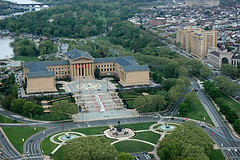
Philadelphia Museum of Art (picture courtesy of the museum). See it big and check the notes to see where the new Perelman Building expansion will be.
Provoked by the closing of Spector Gallery, a reader wrote me at the Weekly asking for more stories about the business of art in Philadelphia. See post for more. The reader felt that there was a conundrum here that needed teasing out: To wit, the economy seems booming, public art institutions like the PMA and PAFA seem to be expanding. Even the Barnes will be digging its way out of a financial hole. Yet the money doesn’t seem to be flowing in to the commercial galleries – or to artists. So what the heck is going on?
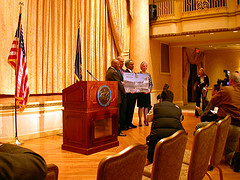
Money speaking in the art world. Press conference announcing the state’s $25 million contribution to the Barnes move. Left to right are Bernard Watson (Barnes), Ed Rendell (state), John Street (city) and Rebecca Rimel (Pew Trusts)
As I told the reader, I’m no economist — or sociologist either — but my anecdotal evidence is that things are not all that dire in the commercial world. Sure galleries come and go but the reasons are complex and yes, financial, but also having to do with personal reasons. Galleries are businesses and they’re run for the most part by people with a passion for art. Mostly those people don’t have MBA’s and none of them has a development office with full time staff to beat the bushes for money. It’s remarkable that as many stay alive as do.
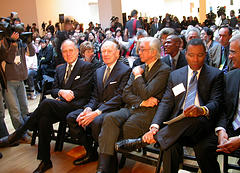
One of my favorite pictures (although blurry). Money speaks, II. The MoMA high priests before the press opening of the new multi-million dollar building on 53rd St.
But I see galleries now selling works to the PMA and PAFA that had never done so before. I see galleries that are selling-out shows. I see galleries embracing the international art fairs. This was not the case in 1999 when I started covering art for the Weekly, when few galleries participated in the out of town fairs. Now a bunch of galleries are out there representing Philadelphia to the world. It’s good for business, good for local artists and it’s good for the city.
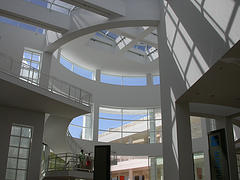
Getty Museum atrium. The Richard-Meier-designed buildings and campus are palatial.
Philadelphia is a conservative place and that means financially too. Collectors with big bucks still run to New York. That’s been a problem since Philly stopped being the capitol in 1790 and became instead a stop between NY and Washington. But what I see is that galleries are coaxing money from the hands of local collectors and corporations and institutions now more than before. The Old City Arts Association and others — Inliquid? Cultural Alliance? –should carpe diem and mount a “buy local” campaign and keep hammering away at it year in year out. That might help keep the dough at home.
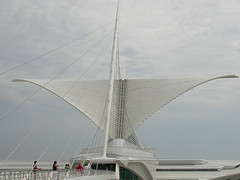
Here’s a museum that lived on the edge for a while. Milwaukee Art Museum which went $25 million into the red in overages from its Santiago Calatrava-designed addition. This is not a city with big money but they beefed up their board and leaned on it and raised the funds.
As for the public art institutions, if they have acquisition budgets it’s because they’ve now earmarked funds to buy – something they haven’t been doing a lot of in say the last 15 years. They’re playing catch up. But flush? Ask the Cultural Alliance about Mayor Street cutting the arts and culture budget in 2005 and how that impacted public and non-profit institutions. See post about how much was actually cut and post about the Office of Art and Culture being canned. Is the Mural Arts Program rolling in dough? Is the ICA? Like all institutions they live on budgets that are modest considering what great programming they do.
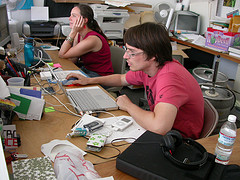
It’s people in the non-profits who make it happen there. Manning the desk at Vox Populi, Max Lawrence and Samantha Simpson. There’s no development officer, just individuals working their networks.
None of our local institutions is run like the Guggenheim with a CEO-type at the top. They’re run by arts professionals who love being in the art world. They’re not making salaries in the millions. Philadelphia institutions are not flush like, say, the Getty. And indeed Philadelphia is not Los Angeles or New York. There’s money here but not like in those two towns. The way institutions court private sponsors for their programming is like that canary in the mine – it’s an indicator of how strong financially the non-profits are. They’re so strong they have to walk this risky line of asking Advanta or some other conglomerate to sponsor a show. I can’t believe museum directors don’t lose some sleep over that, dreaming about the whole “system” of corporate sponsorship spinning out of control and compromising their programming instead of facilitating it. We’re all holding our breath over that issue.

Ben Woodward, one of the founders of Space 1026, seen here at Jim Houser’s show at Spector Gallery in 2005. Space 1026 began in 1998. If you’ve been there you know what an extraordinary bee hive of activity it is. The joint is still kicking–how do they do it?
Commercial galleries sometimes have sponsorship for events and shows and hey, why not? I don’t want to see The Victory Brewing Company Vox Populi” but why not do like the institutions and have a room named the Victory Garden and let that company cough up a little dough to help run the organization.
So what do you think? Is Philadelphia’s gallery scene on the upswing? And how about the artists? Is there dough trickling over into our pocketbooks from what’s going on in the galleries or public institutions? The issues are complex and this doesn’t really do it justice but I’m tossing it out there to get some feedback.









